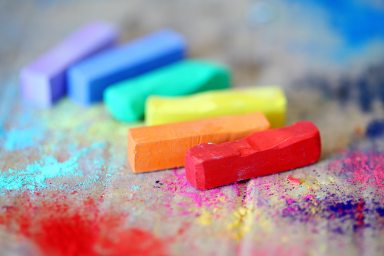Introduction- Can Curation Help Students?

Whenever I participate in professional development, I listen or read information through the veil of how I could use the skills to help my students. If the connection is not clear, I quickly lose interest. So, I was surprised to find inspiration for my classroom when reading about professional curation this week. I teach my students how to select the best resources for research, how to cite them, and how to use them in their writing. However, I have never introduced the topic of curating resources not necessarily related to a specific research question. My students generally know how to bookmark sites and how to access the district’s Symbaloo and their teacher’s collections of resources, but the ability to find and collect their own resources never even entered my mind. With so many sites and tools available to us, it would be a beneficial skill to teach them how to collect and contextualize the resources that are useful to them in school or in their personal lives. What struck me most in my readings about curation were the reiteration of the importance of contextualizing the sources you select for yourself and others who see your collections. I began thinking more about how the process of curating, and especially contextualizing, helps us think critically, question our sources, summarize and synthesize, and do many other skills that we want our students to learn. To my readers, please comment about teaching or using curation with your own students. What have you tried and how did it go?
What Experts Say about the Benefits Curating

Other than just being able to save and access resources you want to use again in the future, the process of curating helps you in a number of important ways that would benefit teachers as well as students.
- Contextualizing the Content
- Joanne McNeil in a video entitled, “What is Curation” says, “A good curator is thinking about not just acquisition and selection but also contextualizing” (2014). So not just saving a great tool, but explaining how it works, where it came from, and maybe even how to use.
- Robin says from “PKM as pre-curation” that, “Curation is about making sense of a topic/issue/event /person/product etc. for a specific audience” (Jarche, 2012). The act of contextualizing helps your audience as well as yourself. Many people blindly save or even share links to articles that seem interesting, but they don’t necessarily spend the time to reflect on the work to determine how it is useful.
- Jarche also adds that, “The act of writing a blog post, a tweet, or an annotation on a social bookmark all force you to think a bit more than clicking once and filing it to an automated system” (2012). This process of thinking about each resource would definitely help students who have grown up on social media where sharing pictures and articles without needed to justify their choices.
- Use for Reflection
- Larry Ferlazzo, a longtime curator, blogger, and teacher from California notes in one interview how, “In addition, I began to write about what things I was doing in class what things worked, what things didn’t work, and found that that was really helpful for me as a process. It helped my thinking, helped me become a better teacher to just think through what I was doing and to get people’s feedback” (Shareski, 2014). Ferlazzo shared his resources and strategies to remember them as well as reflect on how they worked and hear tips from others as well.
- Richard Byrne, author of the Free Teacher technology blog, states in another interview how: “a link is great but people really want to know what can you do with that link” (Shareski, 2014). So curating helps him to focus on the most realistic and useful of sources.

- Importance in Avoiding Bias
- Byrne also adds that he uses curating as a reminder to “try to keep my own bias out of reviews” (Shareski, 2014). Being aware of our own biases and noticing them in others is a crucial skill in this digital age.
- Eli Pariser, in his TED Talk, says how, “You can’t see how different your search results arefrom anyone else’s,” when sifting through results online, so curating sources is another way to make sure others are aware of resources they may not be exposed to or news stories that get glossed over (Pariser, 2011).
My First Attempt at Professional Curation

This past spring, my administration introduced the idea of Mass Customization Learning Communities to our school, with the promise that it would be important. They attended a conference at the Lancaster Lebanon IU 13 this summer to learn about how to implement Mass Customization in our school, and then promptly sent out the pdf of notes from the meeting with an email blurb highlighting this as an important professional development topic for next year. Thus, I decided to take a look at what personalized learning and Mass Customization was while I had the opportunity to research something controversial. A number of sources I looked at were either too school specific, too lacking in credible information, or cost too much for me to use in this project. So, I started a Pinterest Board (which I was already familiar with) to begin finding sources that would give me an overview of what mass customization is, how to start using the philosophy, what the benefits are, and what the critiques of this system of learning are as well. I learned a great deal from my initial searches, and also already some trouble finding articles that gave enough specific information about what this model truly looks like in a school. Many articles give vague compliments to personalizing learning without telling you the essential steps to go through to back it a reality. Readers, please let me know if you have any experience with this concept! I’d love to hear your thoughts!
I will continue researching and learning over the next few weeks, but without further ado here is a link to my Pinterest Board on Mass Customization Learning Communities.
References:
Jarche. H. (n.d.). PKM as pre-curation. Retrieved from http://jarche.com/2012/07/pkm-as-pre-curation/
Pariser, E. (n.d.). Transcript of “Beware online “filter bubbles””. Retrieved from https://www.ted.com/talks/eli_pariser_beware_online_filter_bubbles/transcript
Shareski, D. (2014, March 08). All About Curation. Retrieved from https://www.youtube.com/watch?v=S0Ml4RK4j0Q&feature=share
Shareski, D. (2014, March 09). All About Curation 2. Retrieved from https://www.youtube.com/watch?v=UbxK-M4WsIM
Why Curation Matters. (2014). Retrieved from http://blog.web20classroom.org/2014/05/why-curation-matters.html
Hi Kristen,
First of all I wanted to let you know you your blog post is exceptional! If anyone was unsure as to what curation is or how can be used in the classroom they need to read your post. I teach first grade so curation is not a something I would use with my students in my classroom; however it is something I would use for my professional use in the classroom. Being organized and having reliable sources is a must for teachers.
You made a comment about when you are part of professional development you try to think how you could incorporate what you are learning into your classroom. If you are unable to do so then you loose interest and stop listening. I too am the same way. I also try to think about my students when I am learning in professional development and if what is being discussed is not relevant to me or my classroom I cannot make connections. This is also true with my students. If what is being taught is not relevant to them there is little learning.
Curation is a great way for students to gather reliable sources and organize their sources for sharing, collaboration and future use.
Thanks for your great thoughts.
Shelly
LikeLike
Hi Shelly,
Thank you for reading and commenting on my post! Your point about how we need relevancy in professional development is the same way our students feel was spot on, and it didn’t even occur to me. When preparing my students for a standardized test, it is hard to make every bit of information relevant, but we definitely need to try. I wonder if you could use curation with your students at a very simple level, such as having each student choose an image or their favorite book from a larger database, and explain their choice. Then you put all the images and explanations together the students have their own curated site. You would need to work out the logistics, but it is possible depending on your goals for the lesson.
Thanks again!
Kristen
LikeLike
Hi Kristen,
This was a great post. Your overview of curation and how it can be used for organization and education was exceptional. I enjoyed your summation of the experts’ advice.
I must say I have never heard of mass customization. Had you and other teachers heard this term in reference to education prior to your school district’s presentation? It’s always so difficult to be told that [insert trendy buzzword here] is sure to be the next big thing in education. From what I understand, mass customization is all about customizing the learning process for each individual student to maximize the amount of learning by doing, rather than sitting and listening in a traditional classroom. What are your current thoughts on this? Does it really sound promising, or just another trend that will be a distant memory in another 5 years or so?
I look forward to seeing your final presentation on this topic. Good luck with it!
LikeLike
Hi Josh,
Thank you for the read and comment! I think that while we may call it by another name (personalization, customization, etc), the idea of differentiation instruction for all of our students, regardless of if they have an IEP or 504, will be around in another 5 years because technology allows us the ability to do so. In theory, allowing students to choose the types the projects they explore, the topics they research, even to a point how they spend their time during the school day, should be more flexible than it currently its, especially in a 1:1 school. There are some examples of schools, such as in Copenhagen, with open plan schools that allow for ‘learning zones’ as opposed to classrooms and grade levels (Jenkin, 2015). I think that mass customization is just one trend towards this overall focus on more individuality in education. While this seems daunting, it would also be exciting to see students genuinely excited about what they are doing each day!
Kristen
Reference:
Jenkin, M. (2015, February 11). Inside the schools that dare to break with traditional teaching. Retrieved from https://www.theguardian.com/teacher-network/2015/feb/11/schools-students-traditional-teaching
LikeLike